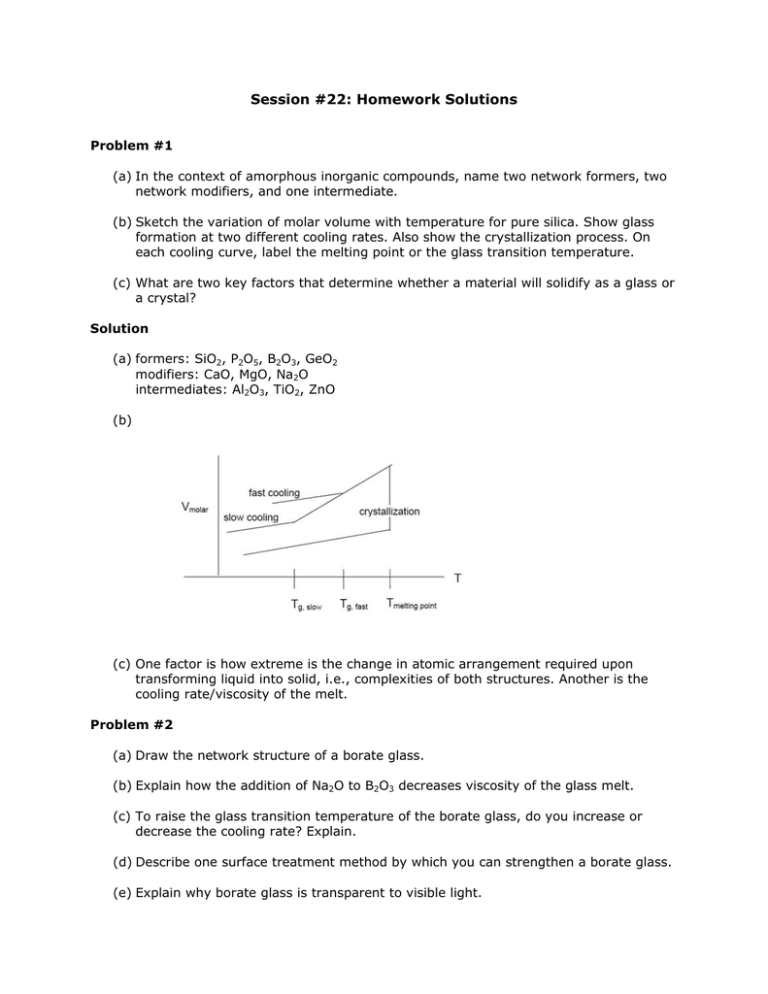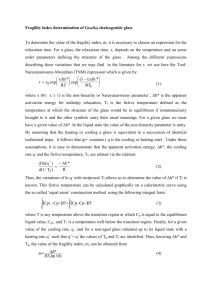Session #22: Homework Solutions
advertisement

Session #22: Homework Solutions Problem #1 (a) In the context of amorphous inorganic compounds, name two network formers, two network modifiers, and one intermediate. (b) Sketch the variation of molar volume with temperature for pure silica. Show glass formation at two different cooling rates. Also show the crystallization process. On each cooling curve, label the melting point or the glass transition temperature. (c) What are two key factors that determine whether a material will solidify as a glass or a crystal? Solution (a) formers: SiO2, P2O5, B2O3, GeO2 modifiers: CaO, MgO, Na2O intermediates: Al2O3, TiO2, ZnO (b) (c) One factor is how extreme is the change in atomic arrangement required upon transforming liquid into solid, i.e., complexities of both structures. Another is the cooling rate/viscosity of the melt. Problem #2 (a) Draw the network structure of a borate glass. (b) Explain how the addition of Na2O to B2O3 decreases viscosity of the glass melt. (c) To raise the glass transition temperature of the borate glass, do you increase or decrease the cooling rate? Explain. (d) Describe one surface treatment method by which you can strengthen a borate glass. (e) Explain why borate glass is transparent to visible light. Solution (a) Courtesy of John Wiley & Sons. Used with permission. (b) Na2O is a modifier. It dissociates to from Na+ cations and O2- anions. The oxide anions attack the bridging -O- oxygens in the borate network thereby disrupting it. The resulting smaller borate units are able to move more easily that the antecedent larger units. This is manifest in the lower value of viscosity for the modified melt. (c) Increase. As high cooling rates there is not enough time for the melt constituents to rearrange themselves before the temperature has fallen to the point at which the existing structure is rendered immobile. (d) One method is ion exchange. Immerse the glass in a molten salt containing alkali cations that are larger than those present in the glass. The concentration gradient in such cations will drive them to diffuse into the glass where they will substitute for smaller ions. This results in the generation of compressive stress in the surface and raises the level of stress needed to break the glass A second method is tempering. Subject the glass to surface cooling by air jet. This leads to differential cooling rates: the surface region is cooling at a higher rate than the interior. If you look at a plot of V vs. T, the final volume of the fast-cooled surface layer will be greater than that of the slow-cooled interior. This results in the generation of compressive stress in the surface and raised the level of stress needed to break the glass. (e) Some reasons for transparency: covalent bonds; tightly bound electrons; high band gap energy, ~5 eV; no dopants that would introduce donor or acceptor levels, e.g. the Hope diamond. Problem #3 The decay rate of 14C in living tissue is 15.3 disintegrations per minute per gram of carbon. Experimentally, the decay rate can be measured to ±0.1 disintegrations per minute per gram of carbon. The half-life of 14C is 5730 years. (a) What is the maximum age of a sample that can be dated and what is the uncertainty associated with this measurement? (b) What is the minimum age of a sample that can be dated and what is the uncertainty associated with this measurement? Solution (a) Radioactive decay is a 1st order reaction which can be modeled as: − dc = kc or c = co e-kt dt With a little algebra we can get an expression for the relationship between time, t, and the instant value of the decay rate. At any time, t, we can write − dc = kc = kco e-kt dt (1) and at time zero, − dc = kco dt (2) Divide eq. 1 by eq. 2 to get rt = e-kt ro where to reduce clutter let r = (3) dc . dt Take the logarithm of both sides of eq. 3 and substitute k = With rearrangement, this gives t=- t1/2 ln 2 × ln rt ro ln 2 . t1/2 (4) So, for the oldest specimen we would measure the minimum instant decay rate of 0.1 ± 0.1 disintegrations per minute per gram. Set this equal to rt in eq. 4 and solve for t to get 41585 ± 5730 years. (b) For the youngest specimen we would measure the maximum instant decay rate of 15.2 ± 0.1 disintegrations per minute per gram. Set this equal to rt in eq. 4 and solve for t to get 54 ± 54 years. Note that although the experimental uncertainty remains constant at 0.1 disintegrations per minute per gram, because this is compared against a measurement that can vary from 15.3 down to undetectable, the derived uncertainty in time varies greatly from 54 years to 5730 years, respectively. Problem #4 What is the activation energy of a process which is observed to increase by a factor of three when the temperature is increased from room temperature (20°C) to 40°C? Solution k1 = Ae -EA RT1 ; k2 = 3k1 = -EA RT2 Ae E ⎛ 1 1 ⎞ − - A ⎜⎜ ⎟ R ⎝ T1 T2 ⎟⎠ 1 → = e 3 ln 3 = EA = EA ⎛ 1 1 ⎞ − ⎜ ⎟ R ⎝ T1 T2 ⎠ R × ln 3 = 4.19 × 104 = 41.9 kJ/mole 1 1 − 293 313 Problem #5 A first-order chemical reaction is found to have an activation energy (EA) of 250 kJ/mole and a pre-exponential (A) of 1.7 x 1014 s–1. (a) Determine the rate constant at T = 750°C. (b) What fraction of the reaction will be completed at 600°C in a period of10 minutes? (c) At what temperature will the reaction be three times as fast as at 750°C? Solution (a) k = E - A Ae RT 14 = 1.7 × 10 - ×e 2.5×105 8.31×1023 = 28.8 s-1 (b) Requires knowledge of k600: 14 k 600 = 1.7 × 10 c = e−kt = e co - ×e 2.5×105 8.31×873 −0.184×600 = 0.184 = 1.3 × 10-48 ≈ 0 c = 0 means the reaction is essentially 100% complete. (c) k = 3 × k1 = 3 × 28.8 = E - A RTx Ae ln 86.4 = ln(1.7 × 1014 ) Tx = ( EA RTx EA R ln 86.4 - ln(1.7 × 1014 ) ) Tx = 1063 K = 790oC Problem #6 Whiskey, suspected to be of the “moonshine” variety, is analyzed for its age by determining its amount of naturally occurring tritium (T) which is a radioactive hydrogen isotope (3H) with a half-life of 12.5 years. In this “shine” the activity is found to be 6% of that encountered in fresh bourbon. What is the age of the whiskey in question? Solution co = ekt ; c = 0.06co c ln co = kt x 0.06co ln 0.06 = -kt x tx = - ln 0.06 ln 0.06 = = 50.7 years ln 2 0.693 t1/2 12.5 MIT OpenCourseWare http://ocw.mit.edu 3.091SC Introduction to Solid State Chemistry Fall 2009 For information about citing these materials or our Terms of Use, visit: http://ocw.mit.edu/terms.



